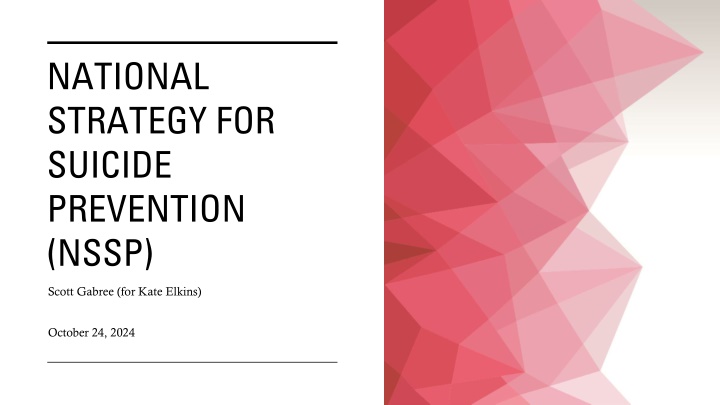
National Strategy for Suicide Prevention Overview
Explore the National Strategy for Suicide Prevention (NSSP) focusing on a collaborative approach across government agencies. Learn about the development process, key contributors, and the updated strategy published in April 2024. Discover the goals, action plans, and the involvement of the Federal Railroad Administration (FRA) and the National Highway Traffic Safety Administration (NHTSA) in this critical initiative.
Download Presentation

Please find below an Image/Link to download the presentation.
The content on the website is provided AS IS for your information and personal use only. It may not be sold, licensed, or shared on other websites without obtaining consent from the author. If you encounter any issues during the download, it is possible that the publisher has removed the file from their server.
You are allowed to download the files provided on this website for personal or commercial use, subject to the condition that they are used lawfully. All files are the property of their respective owners.
The content on the website is provided AS IS for your information and personal use only. It may not be sold, licensed, or shared on other websites without obtaining consent from the author.
E N D
Presentation Transcript
NATIONAL STRATEGY FOR SUICIDE PREVENTION (NSSP) Scott Gabree (for Kate Elkins) October 24, 2024
THANK YOU FOR ALL YOUR WORK! MESSAGE FROM KATE ELKINS: Thank you, Scott for stepping in to present for me. I am sorry I am unable to make it to Chicago! Thank you all for being here to advance this important work! I have been blessed to participate in the White House Interagency Policy Committee for Suicide Prevention and numerous other federal working groups to improve our strategy and actions to prevent suicide in our country. During my time at DOT, with the NHTSA Office of Emergency Medical Services (EMS), I reached out to the other modes of transportation for their help documenting how DOT was involved in suicide prevention. FRA was already busy with grants and prevention programs. They quickly became engaged in the revision of the national strategy and continue to do excellent prevention and awareness work! It has been a pleasure collaborating but also watching as this team continues to lead our transportation colleagues in this important work! Although EMS respond to incidents where people are injured on our rails, it is FRA and all of you have been leading the work to prevent these tragic incidents and for that I, and all my EMS peers, are thankful.
NATIONAL STRATEGY FOR SUICIDE PREVENTION Published in April 2024 Prior version published in 2012 Both a higher-level Strategy which describes the goals for how to approach this challenge AND a more detailed Action Plan which describes specific tasks which can be taken to achieve these goals
NATIONAL STRATEGY FOR SUICIDE PREVENTION Huge cross-governmental collaboration FRA and NHTSA are the two modal administrations representing DOT Great opportunity for building relationships and forming connections across government departments and agencies
DEVELOPING THE NATIONAL STRATEGY FOR SUICIDE PREVENTION (NSSP) White House Interagency Policy Committee (IPC) for Suicide prevention helped identify points of contact for different departments for the SAMHSA working groups for the revision of the NSSP DOT effort was led by NHTSA (Kate Elkins) who helped to organize content from each DOT mode FRA was a leader, as is clear in the content of the Action Plan
NSSP ACTION PLAN: STRATEGIC DIRECTION 1: COMMUNITY BASED SUICIDE PREVENTION DOT/FRA will advance implementation of its National Strategy to Prevent Trespassing on Railroad Property through data-driven programs that will evaluate the risks of trespasser incidents throughout the nation s rail network and work with communities and law enforcement to facilitate the implementation of effective prevention strategies. DOT/FRA will continue to collaborate with international partners to share best practices related to railroad suicide prevention, which includes developing a partnership with the Global Railway Alliance for Suicide Prevention (GRASP), an international working group focused on railroad suicide prevention. DOT/FRA will increase opportunities for industry partners to share insights regarding suicide prevention challenges and successes, such as the FRA-hosted quarterly meetings of the Suicide Prevention for US Rail (SPUR) working group. DOT/FRA/Volpe Center will continue to enhance and maintain a Rail Suicide Prevention Resource webpage.
NSSP ACTION PLAN: STRATEGIC DIRECTION 1: COMMUNITY BASED SUICIDE PREVENTION DOT/FRA will work with other federal agencies to streamline the application process for FRA grant programs and to identify dedicated grant opportunities to reduce barriers experienced by communities at risk for trespassing on the rails and suicide. DOT/FRA will work through the Executive and Congressional budget cycles and reauthorization process to identify funds to strengthen grant programs that provide funding for trespasser mitigation, such as suicide prevention efforts. DOT/FRA will expand the eligibility criteria for applicants to FRA grants to include local law enforcement agencies. DOT/FRA will assess the impact of its current Critical Incident Stress Plan rule in reducing the risk of adverse impacts among employees who experience a potentially traumatic event. Findings will be used to inform improvements to this mandate.
NSSP ACTION PLAN: STRATEGIC DIRECTION 3: SURVEILLANCE, QUALITY-IMPROVEMENT, AND RESEARCH DOT/FRA/NHTSA will collaborate with agencies that collect data related to suicide to identify approaches to reporting and sharing data that will support suicide prevention. As part of the Railroad Information Sharing Environment (RISE) program, DOT/FRA will develop a Web-based Report of Railroad Trespasser Form that can be used by law enforcement agencies to report on rail trespassing enforcement activities to help FRA determine the effectiveness of rail trespass prevention activities and reduce the number of trespasser incidents. DOT/FRA will identify, through independent analysis and collaboration with railroads and other stakeholders, known and new data sources that could better identify trespasser hot spots or risk factors that lead to trespassing. FRA will provide a way for stakeholders to access this information so they can act on it and implement strategies to help address their specific needs.
NEW OPPORTUNITIES FOR GROWTH Direct collaboration with NSSP team and other federal agencies Opportunities to lean on expertise in mental health and suicide prevention Share railroad-specific approaches to gather feedback Opportunities to identify funding sources Opportunities to better protect rail workforce mental health and reduce exposure to traumatic incidents.


